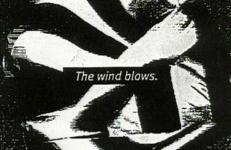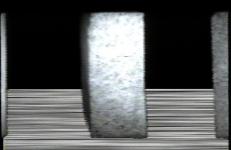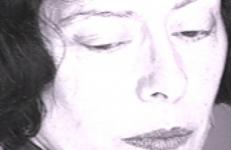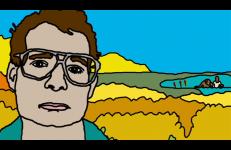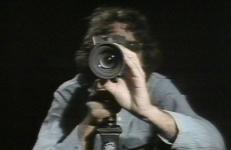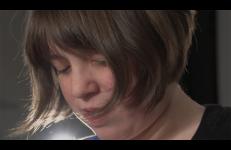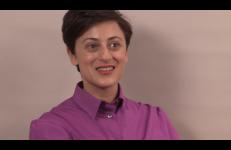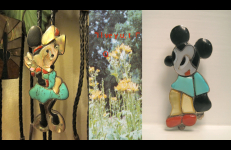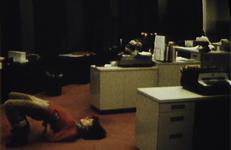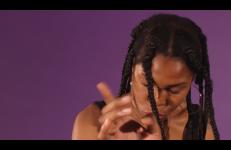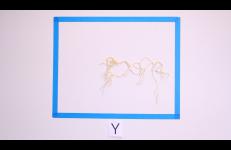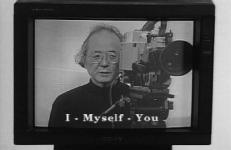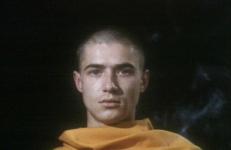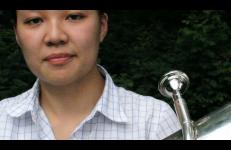Through a process of degeneration of both sound and image, Just endows the iconic American flag with new context and implication. The image is repeated by generations, using different processes such as digital video, computer printout and photocopying, and then combined with degenerated sound. Single frames of original digital images are exported, and evolve through the repetition of process, before being metamorphosed back to digital image by scanning and rendering.
Language
"Bricks, white noise, video. Free floating sync, altered, drifiting camera: video image and time. Keying permutations, switching via gray level values, using a modified b+w Sony special effects generator (SEG). Building the building, one brick at a time. In video what is a brick? In spite of what was then a fierce cultural doxa, an anti-materialist pressure, and being quite anti-anti-materialist I was working hard to coax out significant features as expressive intensity zones, electronic energy points always engaging with the signals."
– Peer Bode
Language Lessons entwines the search for the fountain of youth with the dream of a common language. The fountain both promises and frustrates eternity, while this dream offers hope for common ground. The lessons, made vivid by watery, elemental images and multiple voices, suggest that communication remains at the limits of our imagination.
Music by Pamela Z.
Language Lessons entwines the search for the fountain of youth with the dream of a common language. The fountain both promises and frustrates eternity, while this dream offers hope for common ground. The lessons, made vivid by watery, elemental images and multiple voices, suggest that communication remains at the limits of our imagination.
Music by Pamela Z.
In the early 1990s, I went to a reading by Leslie Scalapino at Intersection for the Arts in San Francisco. I could not understand the writing, which can seem difficult and unwieldy to a reader unaccustomed to language poetry, and understood less the more I tried. After a certain point in the reading I stopped trying to figure it out and I let the words seep in. My reward was an effortless understanding of how her poetry works.
Lesser Apes tells the story of a love affair between a primatologist, Farrah, and a female bonobo ape, Meema. Bonobos are the species with which humans share the most DNA, but unlike our species, they are matriarchal, live without conflict, and are unabashedly sexual. A paean to perversion, the film combines animation, live action and song to challenge attitudes about sex, language and our relationship to nature.
Lesser Apes tells the story of a love affair between a primatologist, Farrah, and a female bonobo ape, Meema. Bonobos are the species with which humans share the most DNA, but unlike our species, they are matriarchal, live without conflict, and are unabashedly sexual. A paean to perversion, the film combines animation, live action and song to challenge attitudes about sex, language and our relationship to nature.
Produced in Liege for Belgium TV, this tape considers how broadcast television functions in a multi-lingual area. A televised Tower of Babble, Muntadas shows the rigid conformity of style and content enforced through the medium, drawing attention to the similiar format of the programs broadcast in different languages.
"Playing like a series of overheard conversations, Life and People grapples with communication, language, and recitation by staging common situations—a doctor’s prognosis, a teacher’s report to a parent—in the director’s signature deadpan, but replicating the awkward interactions of his animation to live-action performances."
-- BAMcinematek, Migrating Forms, 2014
Images of friends and landscapes are cut, fragmented, and reassembled on an overhead projector as hands guide their shape and construction in this film stemming from Hollis Frampton’s Nostalgia. The voice tells a story about a not too distant past, a not too distant ruin, with traces of nostalgia articulated in terms of lore; knowledge and memory passed down and shared not from wistful loss, but as a pastiche of rumination, reproduction, and creation.
Guillermo Gómez-Peña, Gustavo Vazquez, Daniel Salazar, Patrick Litchy, Jethro Rothe-Kushel
Sara Magenheimer earned her MFA at Bard in 2013 and has since shown her work internationally in Canada, Iceland, the Czech Republic, and Denmark. Her cross-disciplinary practice plays with the juxtaposition between the form and content of language, exposing the absurdity of expected meanings.
Memo Mori is a journey through Hackney tracing loss and disappearance. A canoe trip along the canal, the huts of the Manor Garden allotments in Hackney Wick, demolition, relocation, a magical bus tour through the Olympic park and a Hell’s Angel funeral mark a seismic shift in the topography of East London.
This video is about two fictional characters, as in letters, and two fictional characters, as in anthropomorphized mice, falling in love. Just as they start their love-dance they are separated by The Hand of language/culture/logic and are forced to learn and embody new signifiers in order to reunite at the end and finish dancing.
"In late December 2020 I began making videos of bouquets of Anemones using a microscope lens. The very limited focal length of the lens requires that the lens touch the subject to obtain focus. This imaging process developed into an odd intimacy between subject, apparatus and my body as I moved the handheld camera through the bouquets. The audio is made up of processed sync sound, samples from the Forbidden Planet soundtrack and computer voiced words from the Algorithms for Indeterminacy series.
Mutiny employs a panoply of expression, gesture, and repeated movement. Its central images are of women: at home, on the street, at the workplace, at school, talking, singing, jumping on trampolines, playing the violin. The syntax of the film reflects the possibilities and limitations of speech, while “politically, physically, and realistically” flirting with the language of opposition.
An unseen narrator weaves a textual “map of moral acupuncture” as two BDSM scenarios unfold between queer sex workers and their partners. Archive, architecture, land, sky, and touch bind the historical to the present. Where/what are the slippages between subversion and re-inscription? Liberation and retention? Real and fantasy? How do BDSM practices thicken historical narratives around bodies, sex, and power?
Commissioned by the Whitney Museum of American Art and The American Center in Paris as part of their international Trans Voices project, Nation flashes contradictory formulations of language, politics, and medicine across a sharp and close screen. Blurring geography with the body's landscape, Nation reminds us that our bodies, like land, have been shaped by history into zones to be charted, conquered, divided, or made whole. "Think globally act locally," in one dense minute.
Inspired by a riff on a popular joke “Everybody wanna be a black woman but nobody wanna be a black woman,” Notes On Gesture is a video comparing authentic and dramatic gestures. The piece uses the 17th Century text Chirologia: Or the Natural Language of the Hand as a guide to create an inventory of gestures for performance. The piece alternates between title cards proposing hypothetical situations and short, looping clips that respond. The actor uses her body to quote famous, infamous, and unknown women.
An absurdist demonstration of how the alphabet works.
An experimental investigation into the use of race as an arbitrary signifier. Drawing upon language, personal memories and the 1959 text, Black Like Me, it deals with Lacan’s “mirror state” theories of beauty and the movement from object to subject.
This video trilogy of Camera, Monitor, Frame, Observer / Observed, and Observer / Observed / Observer creates a semiology of video as a work on video rather than a written text. Its main purpose is to study the structural relationships between video and language, in this case using the English language. I designed a system depicting the relationship between the observer and the person being observed using words such as "I" and "YOU" through a video feedback system as the basis. This trilogy is a remake of my 1975-76 piece. It is shorter in
A film about haircuts, clothes, and image/sound relationships.
"This four-minute film explores our response to stereotypes—aural, visual and ideological. Smith signals these stereotypes to the viewer through a chiefly associational system, which deftly manipulates the path of our expectations. The structure is stunningly simple and deceptively subtle. We are taken on a journey from one concrete stereotype to its diametric opposite, as images transform and juxtapose to, ultimately, invert our interpretation of what we see and hear."
—Gary Davis
In this diptych, Yi-Ching Chen plays the lowest possible sound on her tuba and Magenheimer's own electronically synthesized voice sings a letter that Ada Byron, the world's first computer programmer, wrote to her mother. In the letter she describes what it felt like to discover the extraordinary power of her own vast intellect.
Text excerpted from a letter Ada Byron wrote to her mother.
Acconci's open mouth is framed by the camera in an extreme close-up, bringing the viewer uncomfortably close. A desperate sense of strained urgency comes across as Acconci gasps, "I'll accept you, I won't shut down, I won't shut you out.... Im open to you, I'm open to everything.... This is not a trap, we can go inside, yes, come inside...." Acconci continues to plead in this way for the length of the tape, his mouth held unnaturally wide open. The pathological psychology of such enforced openness betrays a desperate struggle to accept and be accepted by others.




